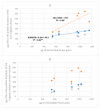Clipping Effect on the Grain Nitrogen and Protein Fractions of Ancient and Old Wheats Grown in a Mediterranean Environment
- PMID: 37444319
- PMCID: PMC10341193
- DOI: 10.3390/foods12132582
Clipping Effect on the Grain Nitrogen and Protein Fractions of Ancient and Old Wheats Grown in a Mediterranean Environment
Abstract
This study is the first to assess the effects of clipping, cultivar, season, and their interactions on the protein composition of six old and ancient wheat cultivars (n = 6). For this, nitrogen content, the proportion of wheat protein fractions, and the molecular weight distribution of the extractable and unextractable glutenin polymers were investigated as a function of cultivar and clipping in two consecutive seasons. The relationships between genotypic variation in grain nitrogen and protein fraction content under clipping and non-clipping conditions were also assessed. Clipping delayed and shortened the grain filling period of all of the cultivars. The protein composition of some cultivars behaved differently to clipping due to differences in the environmental conditions of S1 (exceptional dry season) and S2 (rainy season). In S1, clipping decreased the ratio of gliadins over glutenins (GLI/GLU) (<1) of Cappelli and Giovanni Paolo, while in S2, clipping improved the GLI/GLU of Giovanni Paolo, Monlis, and Norberto. The unextractable polymeric proteins were not affected by clipping. Khorasan was shown to be indifferent to clipping in S1 and S2. These results suggest that it is possible to have ancient/old wheats suitable for a dual-purpose system, in different climatic conditions, while maintaining good grain quality traits. The increased market demand for ancient and old wheats presents an economic opportunity for farmers who adopt the dual-purpose technique to cultivate these resilient crops again and increase their profit margins and revenues.
Keywords: clipping; gluten; grain nitrogen; protein composition.
Conflict of interest statement
The authors declare no conflict of interest. One author (Fatma Boukid) is employed by the company ClonBio Group Ltd. The remaining authors declare that the research was conducted in the absence of any commercial or financial relationships that could be construed as potential conflicts of interest.
Figures



Similar articles
-
N Partitioning between Gluten Fractions in a Set of Italian Durum Wheat Cultivars: Role of the Grain N Content.Foods. 2020 Nov 18;9(11):1684. doi: 10.3390/foods9111684. Foods. 2020. PMID: 33217983 Free PMC article.
-
Suitability of Improved and Ancient Italian Wheat for Bread-Making: A Holistic Approach.Life (Basel). 2022 Oct 15;12(10):1613. doi: 10.3390/life12101613. Life (Basel). 2022. PMID: 36295048 Free PMC article.
-
From seed to bread: variation in quality in a set of old durum wheat cultivars.J Sci Food Agric. 2020 Aug 30;100(11):4066-4074. doi: 10.1002/jsfa.9745. Epub 2019 May 17. J Sci Food Agric. 2020. PMID: 30977135
-
[The high-molecular glutenins of the soft winter wheats from European countries and their relationship to the glutenin composition of the ancient and modern wheat varieties of Ukraine].Tsitol Genet. 2000 Mar-Apr;34(2):104-20. Tsitol Genet. 2000. PMID: 10857209 Review. Russian.
-
Relationship between nitrogen functionality and wheat flour dough rheology: Extensional and shear approaches.Food Res Int. 2022 Dec;162(Pt B):112049. doi: 10.1016/j.foodres.2022.112049. Epub 2022 Nov 1. Food Res Int. 2022. PMID: 36461313 Review.
Cited by
-
Recent Advances in the Assessment of Cereal and Cereal-Based Product Quality.Foods. 2025 Mar 31;14(7):1220. doi: 10.3390/foods14071220. Foods. 2025. PMID: 40238410 Free PMC article.
References
-
- Mefleh M. Cereal-Based Foodstuffs: The Backbone of Mediterranean Cuisine. Springer International Publishing; New York, NY, USA: 2021. Cereals of the Mediterranean Region: Their Origin, Breeding History and Grain Quality Traits; pp. 1–18.
-
- Boukid F., Vittadini E. Ancient Grains and Pseudocereals: Nutritional Value and Food Applications. In: Cooper R., editor. Ancient Grains in Modern Soils. Destech Publications, Inc.; Lancaster, PA, USA: 2022.
-
- United Nations . Transforming Our World: The 2030 Agenda for Sustainable Development. United Nations; New York, NY, USA: 2015.
Grants and funding
LinkOut - more resources
Full Text Sources

